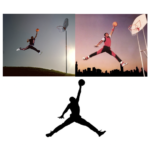In 2015, photographer Jacobus Rentmeester sued Nike, Inc. alleging copyright infringement for the company’s use of its iconic “Jumpman” logo. Last week, the Ninth Circuit Court of Appeals affirmed the District Court’s dismissal of the action.
The photograph of Michael Jordan was first captured by Rentmeester in 1984 and appeared in Life Magazine as part of a photo essay. Inspired by ballet’s grant jete pose, Jordan’s unusual stance is similar to a dancer’s leap with legs extended, one foot forward and the other back. The photographer entered into a limited license agreement with Nike whereby Nike was provided with color transparencies of the photograph for “slide presentation only.” Nike went on to reproduce its own version of the photographer, this time with Michael Jordan donning Nike shoes and the Chicago skyline in the background as a nod to his team, the Chicago Bulls. Later, the signature “Jumpman” logo emerged featuring a solid black silhouette that outlines Jordan’s figure as it appears in the Nike photograph.
To establish copyright infringement, a plaintiff needs to prove (1) that he owns a valid copyright in the work and (2) that the accused copied protected aspects of that work’s expression. While the Ninth Circuit agreed Rentmeester owns a valid copyright in the photograph, the court found he cannot copyright the pose itself, thereby preventing others from photographing a person in the same pose. Instead, Rentmeester is entitled to protection only for the way in which the pose is expressed in the photograph. Otherwise unprotectable elements such as camera angle, timing, and shutter speed, are protectable only to the extent of the photographer’s selection and arrangement thereof. Thus, while both photos embody a similar idea or concept, they express it in different ways so Nike cannot be liable for copyright infringement.

